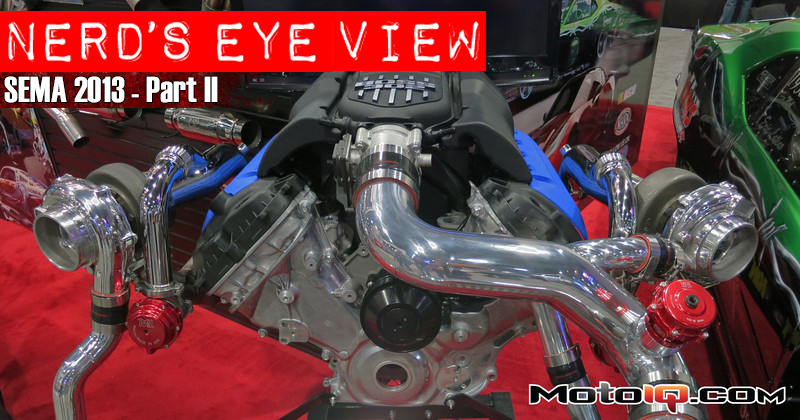,

Ford Racing had this beauty of an engine in the Ford booth. It’s based on the production Ecoboost V6 and was used to power a Daytona Prototype. There are two intake manifolds; one for each bank of three cylinders.

A pair of Borg Warner EFR turbos with the new v-band turbine housings were used paired with TiAL wastegates. Yup, exhaust bellows are used again on the wastegate dump tube to prevent cracking of the tubes.

A dry sump oil system is used along with an ATI Super Damper to keep the engine in one piece.


There appears to be two crank angle sensors reading the toothed wheel. It’s probably not a bad idea to have some redundancy here.

Something else essential to having a reliable track car is maintaining low coolant temperatures. CSF steps in at this point with their line of radiators, intercoolers, and oil coolers. Before getting to what makes CSF products unique, let’s have a look at this Cayman S in the booth! Porsche 911s are like Camrys around Beverly Hills, but a Cayman S, now that’s quite a bit more unique! I forgot to pop the bonnet on the car, but I’m guessing that NACA duct is to feed cooling air to the brake master cylinder area.

What’s the key to CSF radiators? It’s their “B-tube”. Those two extra bends in the middle creating the B shape make all the difference. I’ve done some sheet metal work back in the day so I can speak with some experience in this area. The “B-tube” is so simple, it’s ingenious. The concept is simple; a big flat piece of sheet metal is very floppy just like a piece of paper. If you put a bend in it however, it gets much stiffer. Try it yourself, grab a piece of paper and notice how floppy it is. Now fold it in half to form a sharp crease. The piece of paper is now very stiff in the direction of the crease. Simple right?! So, the “B-tube” adds two bends in the middle along with the short bends also acting as ribs to increase the strength even further. Plus, they add a little more surface area for heat transfer. Due to the significantly increased strength of those two simple bends, much thinner sheet metal can be used to form the tubes. This is beneficial in a number of ways. The first is the obvious weight savings due to the thinner material. The thinner material has an equally important role in increasing heat transfer; by being thinner, there is less resistance to heat transfer. Therefore, the same size “B-tube” will have greater heat flux than an equally sized normal tube. There is a cascade effect as the improved heat transfer means the radiator can be made smaller which saves more weight in reduced size of the radiator and reduced coolant in the system. It’s so simple and yet so brilliant!



